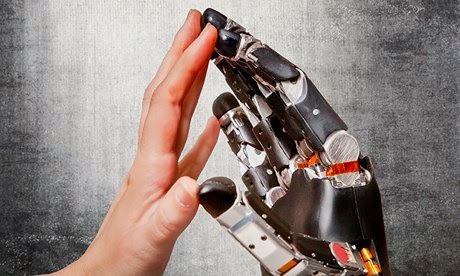The price of computer processors used in robotic prostheses has been driven down by their use in mass-market smartphones. Photograph: PNAS
Being able to put your arm around the shoulder of a friend who is upset and giving them a squeeze may not seem like a significant skill, but it is. Most humans are so good at judging the level of force they exert on others that accidently crushing or bashing someone in such a situation is rarely a problem. For amputees fitted with prostheses such things are not so easy. What they need, of course is that their artificial limbs should have a sense of touch. And that may soon be possible, thanks to some astonishing experiments carried out by a group based at the University of Chicago.
Prosthetic limbs have been going through a bit of a revolution of late. It was not that long ago that the best an amputee could hope for was a cable-controlled pincer hook. Now a person who loses a hand can get a robotic replacement with fully working fingers that allows them to grip and manipulate objects and manage complicated tasks like tying shoelaces or dealing playing cards. This rapid development has been a by-product of the telecommunications revolution, which by making the smartphone a mass-market item has leveraged both the production of cheap superfast silicon chips, and the price of the lithium batteries used to power them. The computer processors in robotic prostheses are used to monitor the electrical signals of the arm muscles and to translate them into the mechanical movement of joints and fingers of the prosthetic hand, while the lightweight battery provides the considerable power needed (see the i-limb). But there is one aspect of the smartphone that has not yet been incorporated into prosthetic limbs: touch sensitivity.
The screens of almost all smartphones have a sense of touch, bestowed on them by a transparent conducting layer made of indium tin oxide, which is continuously monitored by the chip inside the phone. When it detects changes in the electrical activity of that layer, the processor checks to see if they match those of a human finger and reacts accordingly. Thus, as you move your finger on the screen you can scroll a webpage or flick through emails. Importantly, the movement you see on the screen matches what you feel in your hand.
Prosthetic fingers and thumbs do not have a sense of touch, and so amputees have to rely on their visual sense to guide the forces exerted by their prosthetic hands. This is not only inconvenient but annoying, because force feedback, as it is called, is what gives the human sense of touch such sophistication. It is what allows us to gently clink champagne glasses without crushing them, give someone a passionate kiss without bruising them, or increase the grip on a box slipping out of our grasp. In each case we use force feedback to guide our actions, a skill we all learnt the hard way as infants, smashing and crashing our way through childhood.
To give prosthetic hands such force feedback first requires them to be able to detect force. The technology that works on the flat and hard mobile phone screens has to be adapted to the soft, deformable and multiple curved surfaces of a prosthesis – a considerable challenge. Many scientists from around the world are working on developing such materials, including myself, as part of the Light.Touch.Matters team.
We are developing a mouldable plastic material containing piezoelectric powder that can sense pressure at any point on the surface by turning it into an electric voltage. It is recognised, however, that even if we succeed in detecting the pressure associated with contact, there is a bigger hurdle to overcome. The electric signals then have to be translated into the physiological language of the body. In other words, these electric voltages have to be plugged into the nervous system and interpreted in the brain as a sense of touch. The feasibility of achieving this was in doubt until a Chicago University research group had a go at doing it and succeeded.
The Chicago scientists reported results of experiments in which electrodes were attached to the nerves of a monkey's hand and, purely by manipulating the voltages, they were able to replicate the perception of physical pressure associated with holding things, showing that the brain is interpreting the simulated nerve signals as touch. This is astounding because it indicates that integrating prostheses into the nervous system is possible, and so opening the door to robotic devices with force feedback and touch sensitivity. The technology has wider implications, since our sense of touch is deeply associated with our feeling of embodiment. You only have to recall the last time you slept awkwardly and woke up with a "dead arm" to appreciate this. If prostheses gain a sense of touch, their philosophical status as "lifeless" may have to be revised.
Source: thegardian

0 comments :
Post a Comment